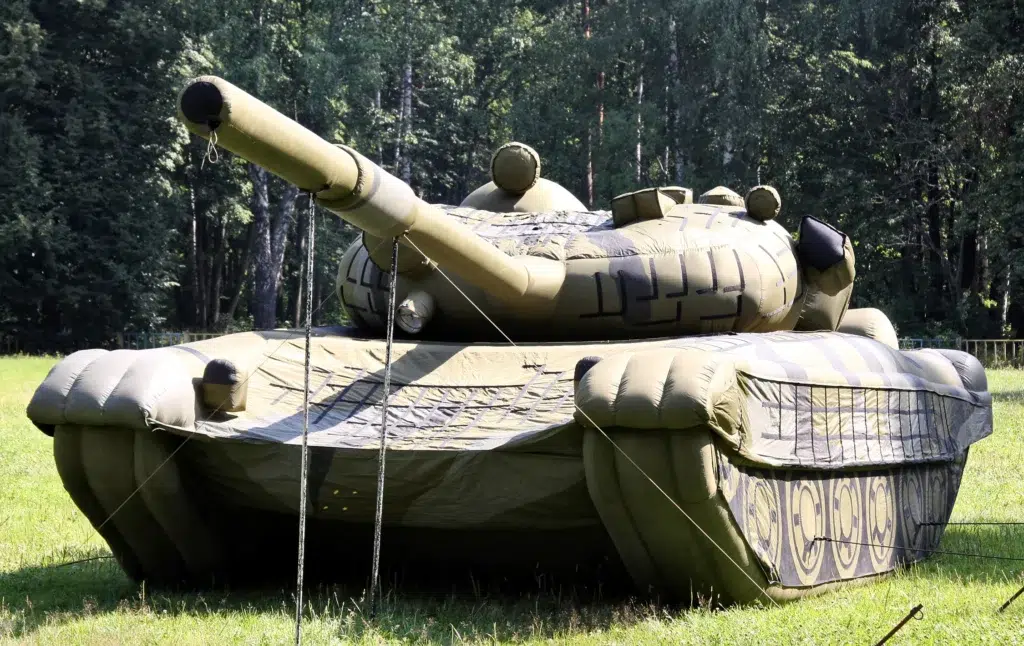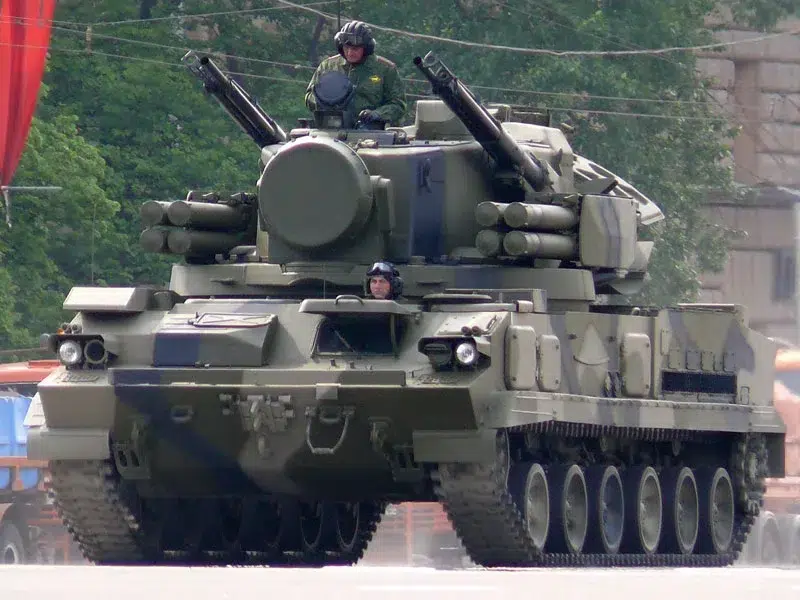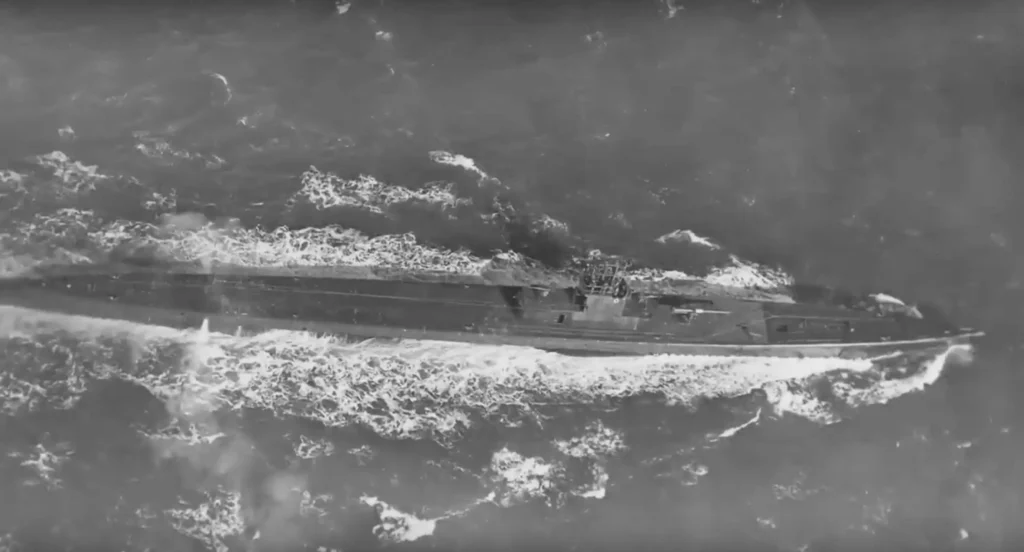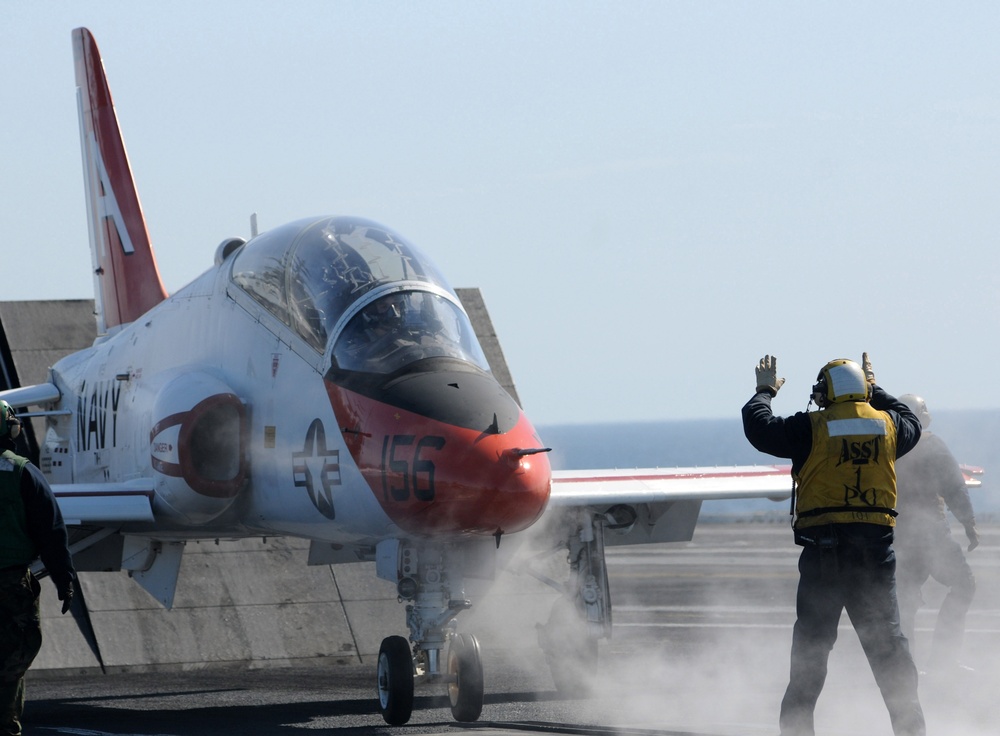Inflatable tanks and artillery: A WWII trend reappears in Ukraine
- By Hope Seck
Share This Article

The concept is so simple, it’s almost child’s play: position visually realistic and accurately sized inflatable tanks and other major assets on the battlefield, and watch your enemy waste valuable munitions trying to take them out while they miss the much more costly real combat assets operating under their noses. But it’s not silly if it works.
This strategy, in its most rudimentary form, was pioneered in World War II by American forces who created a “Ghost Army” of inflatable decoys and other ruses intended to make a combat force seem much larger than it actually was. But it has returned to prominence in Russia’s war on Ukraine, where both sides are employing the deception tactic to get a leg up on the enemy. And recent contracting solicitations indicate that the U.S. military is also seeking to study and train in the technique.
Drone footage released last week by the Ukrainian armed forces appears to show an entire field of Russian T-72 tanks, a Soviet model that makes up most of the country’s tank inventory, in what news outlets and open-source accounts have suggested is Ukraine’s Zaporizhzhia Oblast to the south. But closer observation reveals that, under a light cover of tree branches and brush for camouflage, the turrets and hulls of the tanks have puffy rounded edges – a tell-tale sign that they’re all inflatable. The footage shows three of these decoys, one parked beside what looks like train tracks. The tanks likely belong to Russia’s 45th Separate Camouflage Engineer Regiment, according to the X account AFV Recognition, which posted the footage.
A thread of inflatable vehicles I seen whilst researching the 45th Separate Engineer Camouflage Regiment Mil No.58142, based at Inzhenerny 1. The regiment uses inflatable ‘vehicles’ of all kinds, these are surprisingly not just MBT’s and APC’s yet full S-300 batteries and radars. pic.twitter.com/9innfuxe36
— AFV Recognition (@AFVRec_) January 7, 2023
In a separate thread begun in January, the account has posted an astonishing variety of inflatable armored vehicles and mobile artillery assets owned by the regiment, including S-300 and S-400 missile batteries with elevated radars; fighter aircraft; logistics trucks; and many, many tanks. The account adds that the decoys are especially effective at night because of built-in heat packs that provide a realistic thermal signature to fool even night-vision and infrared cameras.
Related: 300 million bullets and counting: America’s military aid to Ukraine
Meanwhile, Ukraine has its own decoy army with a wide array of inflatables as well as some creative imitation equipment made out of wood, wire, and metal.
Czech company Inflatech has received global news coverage over its claims that business is up 30% year-over-year as the war rages on.
Inflatech’s dozens of inflatable decoys for sale include the High Mobility Artillery Rocket System, or HIMARS, which has been a massive battlefield asset for Ukraine, and a range of NATO military equipment.
Czech TV @ReporteriCT: Czech 🇨🇿 production of inflatable decoys HIMARS, which are delivered to Ukraine 🇺🇦
— Tarmo 🇨🇿 🇺🇦 🇫🇮 🇪🇺 (@TarmoFella) February 22, 2023
(English subtitles added) pic.twitter.com/wiyKTjCRSK
While Inflatech isn’t saying who its customers are, the X account OSINTtechnical posted images in February that appear to show both decoy HIMARS and M777 howitzers, which have also been provided to Ukraine by the United States.
Ukrainian HIMARS and M777 decoys in the east pic.twitter.com/Db2wPQ3jih
— OSINTtechnical (@Osinttechnical) February 22, 2023
Reportedly made from synthetic silk, these inflatables can cost tens of thousands of dollars apiece, which makes them expensive for something explicitly designed to draw enemy fire. But that’s all relative: Guided Multiple Launch Rockets (GMLRS) fired by HIMARS can cost $160,000 apiece before you factor in the costs of operating the launcher.
A recent video published by CNN also appears to show Ukrainian decoys made of very simple materials, including plywood, metal, and plumbing pipes. The outlet reported that company Metinvest is making these imitations for a staggeringly cheap $1,000 or so apiece.
In a world of drone warfare and artificial intelligence, why are these simple decoys so effective at fooling the enemy? In part, the answer has to do with risk avoidance: In battle, choosing not to fire at something that looks like a threat may prove to be a costly mistake. Then, there’s the vulnerability of the human eye, which is incredibly easy to deceive, particularly at a distance.
Dr. Alon Gorodetsky, Associate Professor of Chemical and Biomolecular Engineering at the University of California, pointed to the various examples in nature of simple but highly effective camouflage, from green beetles blending into leaves to zebras’ stripes making their silhouettes difficult to distinguish.
“You don’t have to be high-tech to have excellent deception capabilities within different scenarios,” he told Sandboxx News.
Related: Camouflage colors aren’t just for the Army: A brief camo history
The US military wants its own inflatables

Recent contracting solicitations indicate the U.S. military is paying close attention. The Air Force’s Air Combat Command in July issued a solicitation under “training aids” for a realistic inflatable SA-19 Grisom/2K22 Tunguska self-propelled air defense system, a piece of equipment used by multiple militaries including Russia.
The Army, meanwhile, solicited in July for both an inflatable UH-60 Black Hawk helicopter and an M1 Abrams tank, to be used at Fort Liberty, NC. While the solicitations did not describe the kind of training these items would be used for, they were categorized as “camouflage and deception equipment.”
The service has long run a classified “Army Deception Planner’s Course,” focused on learning deception tactics, techniques and procedures to be applied at any unit level. While the U.S. may not be ready to resurrect its “Ghost Army,” perhaps inflatables and decoys will figure more prominently in deception training thanks to the lessons of Ukraine.
Read more from Sandboxx News
- These are the 5 most underrated Army jobs
- America’s new precision strike missile has China in its crosshairs
- How serious are ‘War Thunder’s’ classified document leaks?
- Complete the mission or follow the rules? Air Force tests AI in flight experiment
- The Navy SEALs’ two original and little-known missions
Related Posts
Sandboxx News Merch
-

‘AirPower’ Classic Hoodie
$46.00 – $48.00 Select options This product has multiple variants. The options may be chosen on the product page -

‘Kinetic Diplomacy’ Bumper Sticker (Black)
$8.00 Add to cart -

‘Sandboxx News’ Trucker Cap
$27.00 Select options This product has multiple variants. The options may be chosen on the product page
Hope Seck
Hope Hodge Seck is an award-winning investigative and enterprise reporter who has been covering military issues since 2009. She is the former managing editor for Military.com.
Related to: Ukraine

‘USS Dorado Project’ aims to solve WWII’s biggest submarine mystery

The Navy’s plan for its next trainer jet shows how carrier aviation has changed
Sandboxx News
-

‘Sandboxx News’ Trucker Cap
$27.00 Select options This product has multiple variants. The options may be chosen on the product page -

‘AirPower’ Classic Hoodie
$46.00 – $48.00 Select options This product has multiple variants. The options may be chosen on the product page -

‘AirPower’ Golf Rope Hat
$31.00 Select options This product has multiple variants. The options may be chosen on the product page -

‘Sandboxx News’ Dad Hat
$27.00 Select options This product has multiple variants. The options may be chosen on the product page
